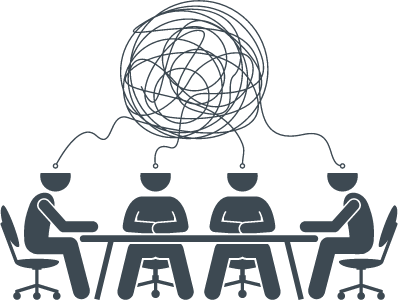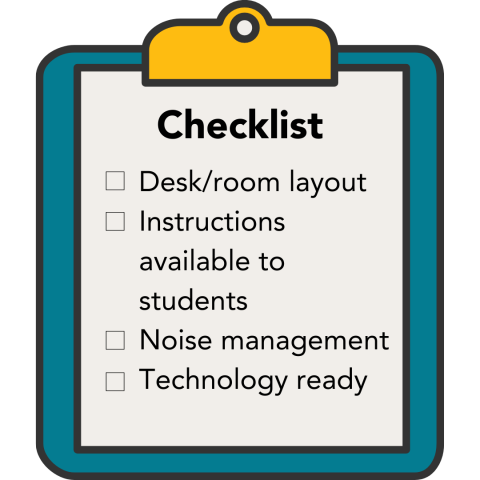Key Elements of Active Learning
Active learning is based on constructivist learning theories, which posit that deep learning takes place in social contexts and through authentic hands-on experimentation, exploration, and interactions between students that help them recognize connections between content and their own prior knowledge. In active learning classes, instructors structure content, activities, interactions, and formative assessments in ways that allow students to work independently and collaboratively to apply, explore, experiment, and reflect on how they think through content.
Elements of Active Learning (PDF) List of Active Learning Strategies
Instructors Act as Guides
Instructors continue to disseminate knowledge, but instead of relying on lecturing, they create learning activities and then act as facilitators and guides who help students navigate through activities. While students are working, active learning instructors use their expert thinking processes to ask probing questions, give more information, correct misunderstandings, and help students talk through their thinking when they get stuck. In this way, instructors teach students to be independent learners while giving them a supportive set of content, activities, and colleagues.
Active Learning in Your Class
Welcoming Atmosphere
Instructors that do active learning set up a class atmosphere that helps the students feel welcomed, respected, supported, and valued as a full participant in the group learning process. When a welcoming atmosphere is established, it becomes easier for students to share their ideas without feeling dumb, wrong, or unaccepted.
It takes time to build a welcoming atmosphere, and is completely dependent on the instructor’s positive attitude, voice tone, and willingness to get to know their students. Instructors do this by building professional rapport with students, and helping students build rapport with each other. This means that instructors take the time to get to know their students’ interests, study habits, and learning needs. They make a visible effort to learn students’ names, create opportunities for students to participate in class activities, and always speak with an encouraging and supportive voice tone – especially when students make mistakes. A welcoming atmosphere encourages students to share ideas, work with each other as colleagues, articulate how they are thinking and learning, and embrace making mistakes so that everybody can learn from them.
Get Students to Participate
Another way that active learning helps students learn deeply is because students can engage with the class content using multiple senses, emotions, and parts of the brain, which creates more neural connections. Things like physical movement, excitement, stories, and taste can all help students remember content better. Simple examples of participation include strategies like polls, think-pair-share, and small group discussions. More complex examples include creating games about the content, letting students help with demonstrations, or student presentations. Regardless of the teaching strategy used, successful active learning depends on getting students to participate in the activities by creating a welcoming atmosphere in which mistakes are a normal part of learning and students feel supported.
Encourage Students to Participate
Solicit and Use Student Contributions to Content
Active learning instructors provide ways for students to contribute their ideas, interests or work to the class content or activities because it helps students feel personally connected to the class, thus deepening their learning. This can happen in very simple ways that also help build rapport with students, like taking a class poll, group brainstorms, or asking students for different ways to start solving a problem. It can also happen in more complex ways, like student presentations of content or solutions, having students contribute data to a class research project, or allowing students to choose the topic for a group project.
Get Students to Think About How They are Learning (i.e. metacognition)
Deep learning through active engagement with content and peers is enhanced when students can talk about how they learn the content. Active learning strategies that are used as formative assessments can help students think through their learning processes when the instructor encourages students to view challenges and mistakes as learning opportunities. As students work through content with others they express their questions, ideas and solutions in ways that reveal how they are thinking through the content.


Classroom Logistics
Classroom logistics for active learning means considering everything and everyone in the physical and temporal space when preparing for active learning strategies. Thus, in a lesson plan the instructor would plan for timing, movement through the physical space, any digital collaboration, placement of desks and chairs, needed materials, and instructions for activities.
It also includes logistics for student behavior during class activities. For example, if you want students to work in small groups of 3-4 people for 10 minutes, will you put them into groups, or do they just work with the people sitting around them? Should they move their desks or chairs? Where will you write instructions for the group activity? How many minutes should they work together? How should they make sure everyone participates? How loud might the room get? How will you get students to quiet down when the small group work ends?
Giving students written instructions about how to construct groups, talk through the content, and complete an activity can reduce the risk of confusion, wasted time, and questions about what to do. Eventually the class settles into a pattern of behavior and it becomes a natural part of class.